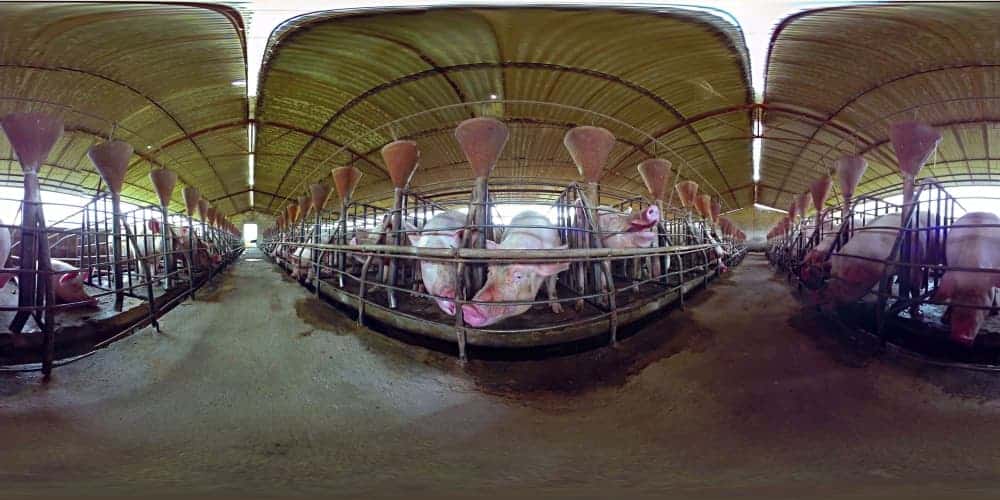Experiencing a slaughterhouse in virtual reality may just be enough to turn you into a vegetarian. At least that’s the idea behind the iAnimal VR experience developed by the animal rights group, Animal Equality. It shows how virtual reality can be a powerful tool for advocacy campaigns. And if you have any doubts on the power of the medium to impact learning, a few minutes in this virtual world is a learning experience you’ll never forget.
The gut-wrenching experience of iAnimal raises questions about how virtual reality experiences will be used in education. We’re already embroiled in debates over the content of textbooks in K-12 and Higher Ed is wrestling with the question of addressing sensitive topics. Virtual Reality could make our current debates look like child’s play.
The Virtual Reality Slaughterhouse

We won’t go into the details – or the images – from iAnimal, but the seven minute VR experience basically takes you through the life of a pig from birth to its inevitable demise. Some of the footage was shot in the U.K. with the remainder in the European Union. You can watch a 360 video version of it online, but it’s not the same as the fully immersive experience in a VR headset. Call it slaughterhouse lite.
Charles Parkinson did the VR version and talks about his experience in Munchies:
Of course, the simple answer is down to our tendency to detach ourselves from the process that ends in meat on our plates. But I always told myself that given the chance, I would go to a slaughterhouse to see if I could handle seeing an animal killed. With abattoirs generally not known for their open-door policy, iANIMAL seemed like a good alternative.
Parkinson survived the experience, but as he notes, he hasn’t touched meat in the three days following it. A preview of the video in Brighton last week drew lines of people with many crying as they went through the experience. And Animal Equity is targeting young people “. . . because they are far more open to adopting new eating habits.”
Perhaps it doesn’t have to be an all or nothing choice. As Parkinson notes,
The overriding message coming from those I spoke to involved in iANIMAL is that if you can’t contemplate giving up meat altogether, eating more humanely reared animals less often is a good start.
Virtual Reality, Learning, and Sensitive Topics
Chris Milk has talked about the way virtual reality engages your senses, the way it feels like life itself:
It’s the first medium that has actually interfaced on a truly human level with our human senses – two of them right now, eyes and ears. Ultimately, what we’re talking about is a medium that disappears, because there is no rectangle on the wall, and there is no page you are holding in your hand. It feels like real life.
That makes it a tremendous force for empathy, the capacity to share another’s experiences and emotions. Even that of an animal. But it will lead to sharp debates over how we use it in education as human experience becomes the issue.
Our current debates in K-12 have largely focused on printed (and some digital) content – words on a page. And Higher Ed debates on offending student sensibilities have mostly focused on speaker invitations and assigned readings. But when experience itself is the learning resource, how will we handle sensitive topics? If we limit access, are we undermining the value of education to challenge our students?
And keep in mind that if we limit virtual reality resources, students will find them elsewhere. iAnimal isn’t in the schools and doesn’t need to be. Young people will line up to see it anyway. And once good VR headsets are in most homes, you won’t even have to line up.
VR will profoundly shift the boundary between informal and formal learning opportunities. And those informal learning experiences will be brought into our institutions just as they are now – but with a far greater intensity. From a student’s point of view, it will be: “I didn’t read about this – I experienced it!”
Virtual reality will launch us on a voyage into uncharted territory in education – just don’t expect the seas to be serene and calm. You might want to reread Homer’s Odyssey as a guide. At least until someone does it in VR.
Emory Craig is a writer, speaker, and consultant specializing in virtual reality (VR) and generative AI. With a rich background in art, new media, and higher education, he is a sought-after speaker at international conferences. Emory shares unique insights on innovation and collaborates with universities, nonprofits, businesses, and international organizations to develop transformative initiatives in XR, GenAI, and digital ethics. Passionate about harnessing the potential of cutting-edge technologies, he explores the ethical ramifications of blending the real with the virtual, sparking meaningful conversations about the future of human experience in an increasingly interconnected world.

